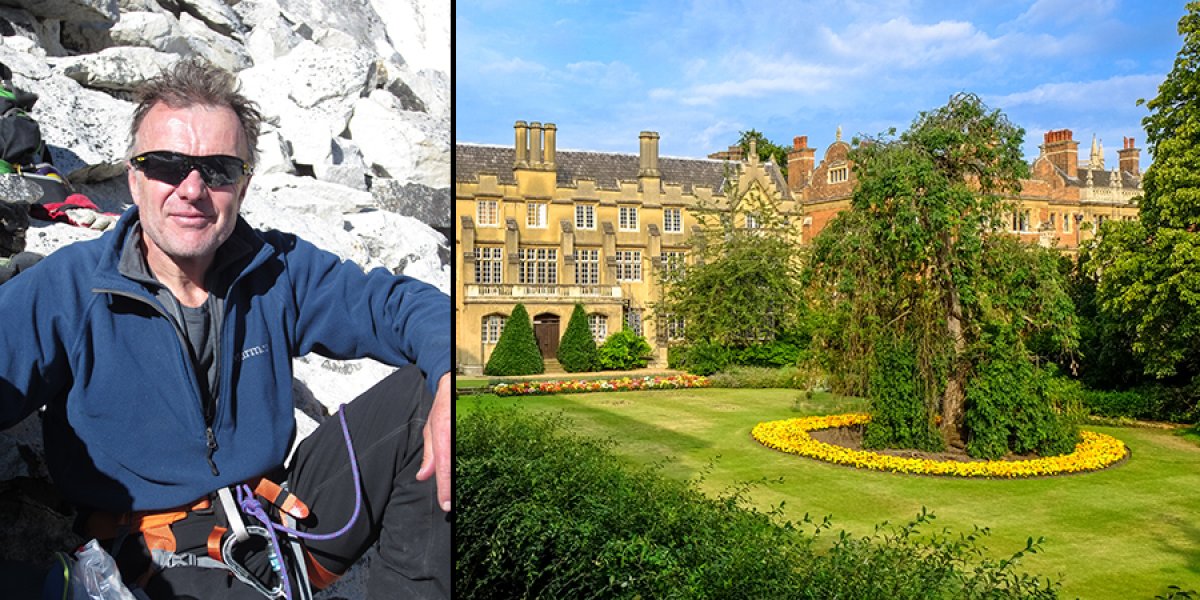In search of the world’s most magnificent mountaineering – Charles Sherwood
Charles Sherwood (Sidney Sussex 1978) describes how secretly scaling up the college chapel led to a lifelong love of mountaineering, and a quest to conquer each continent’s most challenging climb.
A lifetime’s friendship was created as I teamed up with a fellow fresher, Bill Medlicott, to make a bold night-time ascent of our college chapel.
Cambridge is, of course, in the Fens, famous for being flat, wet and windy. There is nothing to climb. Well, not quite nothing…
These days, Cambridge is a demanding institution, or so I’m told by my two daughters, recent graduates from Corpus and Emma. But back in the late 1970s it was almost impossible to fail. There was only one thing you could do that meant automatic expulsion and that was climbing on the college buildings. This of course made the idea irresistible. A lifetime’s friendship was created as I teamed up with a fellow fresher, Bill Medlicott, to make a bold night-time ascent of our college chapel – at least it seemed bold if you had barely climbed before. I recall standing on the chapel roof, about to abseil down the rope now dangling into the courtyard below, when a college porter strode by. I thought, “If he looks up, that’s it. We won’t have made even one term.” Mercifully he didn’t.
Catching the bug
Our prospects of eventually graduating improved as the focus of our climbing endeavours shifted from Cambridge to North Wales. For us teenagers the iconic climb in the country lay in the Llanberis Pass, a huge open book of a feature called Cenotaph Corner. It took me four decades to muster up the courage to lead that route, but I finally managed it last year, albeit on the second attempt, following a 20ft fall at the final crux.
My first serious climb on snow and ice was with another Sidney undergrad, Ted Flint (later Brigadier Flint, Signal Officer in Chief). In the summer of 1980, we headed out to Peru, as part of a self-styled Cambridge Andean Expedition that included my brother Simon, also at Sidney. We hadn’t actually intended any proper climbing, but one volcano sort of led to another and soon we had our eyes on Huascaran, at 6,768m the highest mountain in the country and the fourth highest in the Western Hemisphere. Our local guide, Vicenti, initially scoffed at the idea of taking us up, then cried with fear (literally) and then agreed. The truth was he’d had little choice. He’d been told to take us by the local fixer, whose nickname – Pepe El Loco – spoke a thousand words. This was not a situation my mother, or girlfriend (now wife) at Homerton, would have entirely approved of. However, we made it to the top and back again, having hauled each other out of successive crevasses. Our toes were black with frost bite, but importantly still attached to our feet. I now really had the mountaineering bug!
Seven climbs
Life after Cambridge, and subsequently Harvard, offered rather fewer opportunities for climbing, but I embarked on a series of annual Alpine adventures that culminated in 2007 in an ascent of the North Face of the Eiger. It was as I came off that mountain that I conceived a project, which was to occupy a significant part of my leisure time for the next decade or more: could I find on each continent a climbing route that would rank alongside the legendary Eigerwand, offering a comparable combination of mountaineering challenge, aesthetic appeal and deep historical context? In short: the seven finest climbs in the world.
That quest was to take me from the Alps back to the Andes and on to Yosemite, Kenya, Nepal, New Zealand and Antarctica. I have now put pen to paper and written an account of that journey: Seven Climbs. It has been edited by another Sidney friend, Diane Pengelly, recently married to Bill, my first ever climbing partner. I hope people enjoy it. All the author’s proceeds will go to the Himalayan Trust UK, a charity dedicated to improving the education and health of the mountain peoples of Nepal. The book is in part an opportunity to say thank you to those who, along the way, have tied into the same rope with me.
Charles Sherwood studied History and attended Sidney Sussex.
If you would like to submit your own alumni story, send us an email for details of our submission guidelines.
This article has been written by Charles and the opinions expressed are those of the author.
